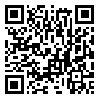Volume 7, Issue 1 (spring 2021)
JMIS 2021, 7(1): 9-18 |
Back to browse issues page
Department of Midwifery Education, Faculty of Nursing and Midwifery, Iran University of Medical Sciences, Tehran, Iran.
Abstract: (3138 Views)
Aim: Childbirth, as women’s most special experience, is associated with negative understandings of mothers, which would be a reason for increasing the rate of cesarean section. Role training is a new educational method that facilitates the visualization of childbirth. The present study was conducted to determine the effect of role-playing training on the expectation of childbirth experience of primiparous pregnant women in Ilam.
Methods: In this quasi-experimental study that was conducted in 2019, 82 mothers who met the criteria were randomly divided into intervention (n = 41) and control (n = 41) groups in comprehensive health centers of Ilam. The training in the intervention group was provided in a role-playing manner during three 40-minute plays. The control group received routine prenatal care. Evaluation of the expectation of delivery experience before the intervention, immediately after the last intervention session, and also one week after delivery, was performed with the Vijma Waiting Experience Examination Questionnaire (WDE-Q) in two groups. Data analysis was performed using SPSS software and an independent t-test, and one-way analysis of variance.
Results: Comparison of scores for the two groups before and immediately after the intervention (P <0.001) and also after delivery and before the intervention (P = 0.001) were significant. The reduction of expectation scores of delivery experience in the intervention group was significantly greater than the control group.
Conclusion: Applying the role-playing training method led to improving the delivery experience. This method can be used during pregnancy to encourage mothers and reduce their stress from childbirth.
Methods: In this quasi-experimental study that was conducted in 2019, 82 mothers who met the criteria were randomly divided into intervention (n = 41) and control (n = 41) groups in comprehensive health centers of Ilam. The training in the intervention group was provided in a role-playing manner during three 40-minute plays. The control group received routine prenatal care. Evaluation of the expectation of delivery experience before the intervention, immediately after the last intervention session, and also one week after delivery, was performed with the Vijma Waiting Experience Examination Questionnaire (WDE-Q) in two groups. Data analysis was performed using SPSS software and an independent t-test, and one-way analysis of variance.
Results: Comparison of scores for the two groups before and immediately after the intervention (P <0.001) and also after delivery and before the intervention (P = 0.001) were significant. The reduction of expectation scores of delivery experience in the intervention group was significantly greater than the control group.
Conclusion: Applying the role-playing training method led to improving the delivery experience. This method can be used during pregnancy to encourage mothers and reduce their stress from childbirth.
Type of Study: Research |
Subject:
Special
Received: 2021/04/11 | Accepted: 2021/05/31 | Published: 2021/05/31
Received: 2021/04/11 | Accepted: 2021/05/31 | Published: 2021/05/31
| Rights and permissions | |
 |
This work is licensed under a Creative Commons Attribution-NonCommercial 4.0 International License. |




